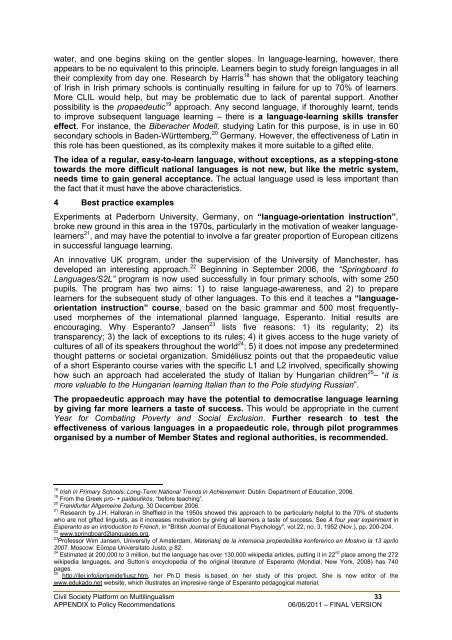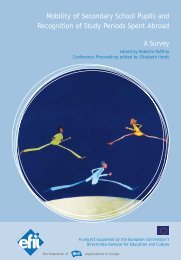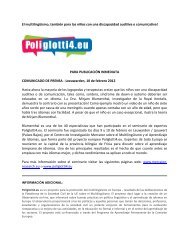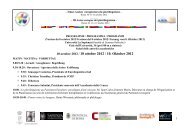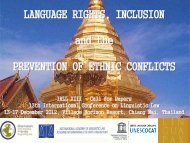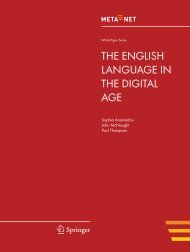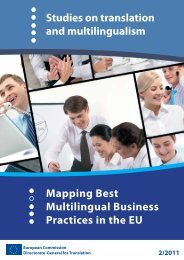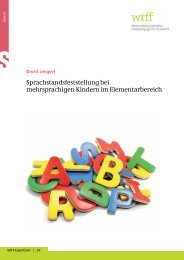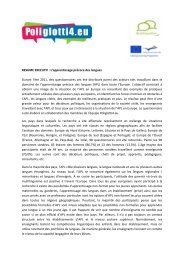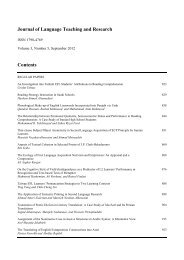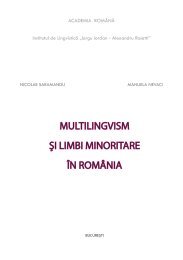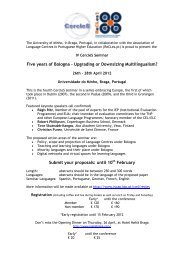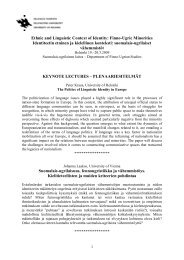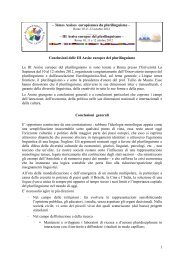FULL VERSION - European Commission - Europa
FULL VERSION - European Commission - Europa
FULL VERSION - European Commission - Europa
You also want an ePaper? Increase the reach of your titles
YUMPU automatically turns print PDFs into web optimized ePapers that Google loves.
water, and one begins skiing on the gentler slopes. In language-learning, however, thereappears to be no equivalent to this principle. Learners begin to study foreign languages in alltheir complexity from day one. Research by Harris 18 has shown that the obligatory teachingof Irish in Irish primary schools is continually resulting in failure for up to 70% of learners.More CLIL would help, but may be problematic due to lack of parental support. Anotherpossibility is the propaedeutic 19 approach. Any second language, if thoroughly learnt, tendsto improve subsequent language learning – there is a language-learning skills transfereffect. For instance, the Biberacher Modell, studying Latin for this purpose, is in use in 60secondary schools in Baden-Württemberg, 20 Germany. However, the effectiveness of Latin inthis role has been questioned, as its complexity makes it more suitable to a gifted elite.The idea of a regular, easy-to-learn language, without exceptions, as a stepping-stonetowards the more difficult national languages is not new, but like the metric system,needs time to gain general acceptance. The actual language used is less important thanthe fact that it must have the above characteristics.4 Best practice examplesExperiments at Paderborn University, Germany, on “language-orientation instruction”,broke new ground in this area in the 1970s, particularly in the motivation of weaker languagelearners21 , and may have the potential to involve a far greater proportion of <strong>European</strong> citizensin successful language learning.An innovative UK program, under the supervision of the University of Manchester, hasdeveloped an interesting approach. 22 Beginning in September 2006, the “Springboard toLanguages/S2L” program is now used successfully in four primary schools, with some 250pupils. The program has two aims: 1) to raise language-awareness, and 2) to preparelearners for the subsequent study of other languages. To this end it teaches a “languageorientationinstruction” course, based on the basic grammar and 500 most frequentlyusedmorphemes of the international planned language, Esperanto. Initial results areencouraging. Why Esperanto? Jansen 23 lists five reasons: 1) its regularity; 2) itstransparency; 3) the lack of exceptions to its rules; 4) it gives access to the huge variety ofcultures of all of its speakers throughout the world 24 ; 5) it does not impose any predeterminedthought patterns or societal organization. Smidéliusz points out that the propaedeutic valueof a short Esperanto course varies with the specific L1 and L2 involved, specifically showinghow such an approach had accelerated the study of Italian by Hungarian children 25 – “it ismore valuable to the Hungarian learning Italian than to the Pole studying Russian”.The propaedeutic approach may have the potential to democratise language learningby giving far more learners a taste of success. This would be appropriate in the currentYear for Combating Poverty and Social Exclusion. Further research to test theeffectiveness of various languages in a propaedeutic role, through pilot programmesorganised by a number of Member States and regional authorities, is recommended.18Irish in Primary Schools: Long-Term National Trends in Achievement. Dublin: Department of Education, 2006.19From the Greek pro- + paideutikós, “before teaching”.20Frankfurter Allgemeine Zeitung, 30 December 2006.21Research by J.H. Halloran in Sheffield in the 1950s showed this approach to be particularly helpful to the 70% of studentswho are not gifted linguists, as it increases motivation by giving all learners a taste of success. See A four year experiment inEsperanto as an introduction to French, in "British Journal of Educational Psychology", vol.22, no. 3, 1952 (Nov.), pp. 200-204.22www.springboard2languages.org.23Professor Wim Jansen, University of Amsterdam, Materialoj de la internacia propedeŭtika konferenco en Moskvo la 13 aprilo2007. Moscow: Eǔropa Universitato Justo, p 82.24Estimated at 200,000 to 3 million, but the language has over 130,000 wikipedia articles, putting it in 22 nd place among the 272wikipedia languages, and Sutton’s encyclopedia of the original literature of Esperanto (Mondial, New York, 2008) has 740pages.25http://ilei.info/ipr/smide'liusz.htm, her Ph.D thesis is.based on her study of this project. She is now editor of thewww.edukado.net website, which illustrates an impresive range of Esperanto pedagogical material.Civil Society Platform on Multilingualism 33APPENDIX to Policy Recommendations06/06/2011 – FINAL <strong>VERSION</strong>


